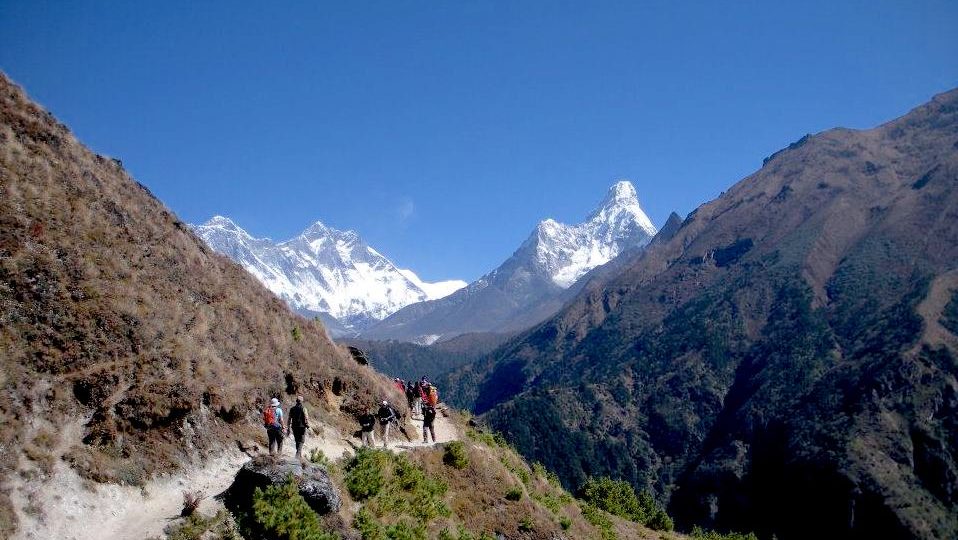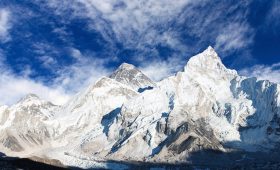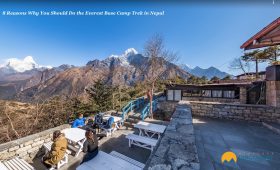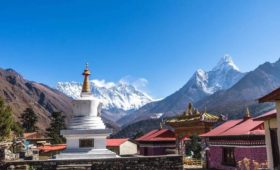The best time to trek the Everest Base Camp depends on your activities. For trekking, you should trek in the spring and autumn, while a helicopter tour can be done whenever the weather is good!
Winter is also an option, as long as you’re prepared for cold temperatures, you’ll be rewarded with stunning mountain views. You’ll find some important things to know about when thinking when to visit EBC below.
Weather & Accessibility
Everest Base Camp is located at a high altitude (17,600 ft / 5380 m), and the overland path to get there is also high.
This means that the Everest area is never really ‘warm,’ but there are still significant differences in temperature, precipitation, and snowfall throughout the year.
Spring and Autumn Seasons
Mid-February to May and mid-September to mid-December are the most popular months for trekking in the Everest region because the weather is at its best during these months.
Spring and autumn tend to offer mild temperatures, sunny skies, little-to-no rain, and a lower risk of problematic snowfall.
These are also the busiest months on the trails, but if you’re looking for the best weather, that’s a trade-off you may be willing to make.
Winter Season
The winter (December, January and February) isn’t actually a ‘bad’ time to trek EBC, but it is obviously the off-season. Temperatures will drop to extremely low levels, so you’d need to be well prepared for freezing conditions.
However, the skies are usually very clear in the winter, allowing for spectacular views of the mountains. And you won’t have to compete for accommodation with other hikers en route.
Monsoon Season
Monsoon season (June to early September) is not the best time to trek EBC. Beside from the rainy weather, which can cause landslides and muddy conditions on trails, rain clouds can obscure scenery. But, temperatures are warmer at this time of year, and it rarely rains every day.
Trekking in the monsoon can be perfect if you’re well prepared for the rain and don’t mind getting a little wet along the way because the higher you go in altitude, the less rain there tends to be.
If trekking isn’t on your list, but a helicopter tour to EBC is, these are both best when the weather is clear and predictable.
The weather may not only have an effect on your experience in the Everest area, but it may also have an affect on flights from Kathmandu to Lukla. Flying is the most common way of getting to Lukla, but flights are often canceled when the weather and visibility are bad in Kathmandu, Lukla or en route.
Flights outside of the monsoon season are more likely to operate as scheduled, but rain, fog or smog can delay flights at any time of year.
Read more on this flight in the following article: How to get to Lukla from Kathmandu.
High Seasons & Alternative Routes
The peak seasons in Nepal are spring and autumn, and as the Everest Base Camp trek is Nepal’s most popular, trails can get crowded during these seasons. There’s no chance you will have the main trails to yourself, and you might struggle to get your first choice of accommodation.
Trekking with a guide is always a good idea, but it is especially important during peak season because they will be able to secure beds for you, which would be difficult if you were traveling alone.
Furthermore, the Everest climbing season lasts from May to early June, so even if you have no plans to climb the mountain, the area will be busy with expeditions during these months.
During the peak season, flights to Lukla sell out quickly, so book as soon as possible.
The classic EBC trail is the most famous, but there are many other treks in the area that do not see as many tourists, even during peak season. Some of these take a separate route to EBC, while others skip it but still provide trekkers with an amazing view of the Everest region’s landscapes, wildlife and culture.
As previously mentioned, the classic Everest Base Camp trek is best done in spring or autumn for the best weather conditions, but these months often bring the problem of overcrowding. To avoid this, consider one of these Everest area alternative journeys instead.
The trekking trail from Jiri to Lukla is an alternative to flying to Lukla from Kathmandu, and it helps you to enjoy some quiet trails before entering the busyness of the Khumbu Valley. The “Pioneers’ Route” was named after the trail that early Western mountaineers took to reach the Everest area before the airport was built at Lukla.
Jiri is located about 8 hour’s drive from Kathmandu. Likewise, fly from Kathmandu to Phaplu and then trek through the Solukhumbu area. These treks last 4 – 7 days and are best done during peak seasons as well as winter.
The Gokyo Lake/Ri Trek is one of the more popular alternatives to the EBC, but it still does not see the same number of trekkers. The Gokyo Lakes system is the world’s highest freshwater lake system.
This trek takes you to the summit of Gokyo Ri, which is around the same elevation as Everest Base Camp and offers stunning views of Everest and its friends. Another advantage is that the trek spends less nights at high altitude than the EBC trek. This trek is best done during peak seasons, when the weather conditions are ideal.
The Everest Three Passes Trek is one of Nepal’s most challenging guesthouse treks, but it’s a good choice for experienced hikers who want to escape the crowds at EBC while still enjoying some of the area’s highlights.
It’s a circuit instead of an in-and-out trek, and each day brings something new. In addition, as the names suggests, you’ll face the challenge of crossing three high passes. This trek is not recommended in the winter because the passes are likely to be snow-bound.
The Arun Valley and Everest Base Camp Trek takes a different approach to the region. It runs through the Arun Valley, between the Sagarmatha and Makalu-Barun National Parks. It follows some of the famous Everest Base Camp route, but diverges enough to keep things interesting. Even during peak seasons, this trail will be almost empty until you join the Everest Base Camp trail.
If you’re traveling in the winter, consider taking a luxury tour—there are some lovely luxury lodges in the Everest region that are on par with comfortable boutique hotels in Kathmandu. While this type of trip is special at any time of year, it is pretty awesome in the winter, when you can enjoy the comfort of a warm, cozy lodge at the end of a day of walking.
Check out this itinerary for a Luxury Everest Heli Trek.
Experienced mountain climbers who don’t want to tackle Mt. Everest but are looking for a challenge should consider climb Island Peak, a ‘trekking peak.’ The best time to attempt this is during peak trekking seasons, which are spring and autumn, as Island Peak isn’t nearly as high (or as risky) as Everest, so has a longer climbing window.
The trek follows a similar route to the standard Everest Base Camp trek and leads to Kala Patthar, from where there are views of EBC.
Festivals
A highlight of visiting in Nepal is experiencing one of the many Buddhist festivals put on all year round.
The people of the Everest region are mostly Buddhist Sherpas, so have a distinct culture from Kathmandu and other hill areas, which are predominantly Hindu.
Mani Rimdu, which falls in either October or November, is one of the most important festivals for the Sherpa people. If you can, try to make it to Tengboche for the festival.
Tengboche Monastery is the most important monastery in the area, and monks perform ritual dances in colorful and elaborate costumes.
Conclusion
At Himalaya Discovery we’ve highlighted spring and autumn are the best time to trek to Everest Base Camp.
Furthermore, gathering together in the evenings over steaming plates of Dal-bhat after a day of hiking through the Himalayas with pristine views of the surrounding peaks is too appealing to resist.
That said, we can happily arrange Everest Base Camp trek at other times of the year as well, so it doesn’t only have to be in the spring and fall.
Please let us know if you’re keen, and we can discuss having you join us on this incredibly thrilling adventure!






